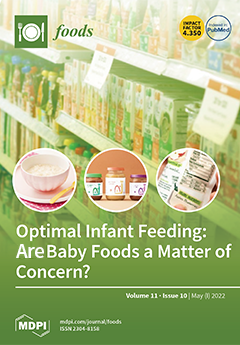Commercially available Irish edible brown (
Himanthalia elongata—sea spaghetti (SS),
Alaria esculenta—Irish wakame (IW)) and red (
Palmaria palmata—dulse (PP),
Porphyra umbilicalis—nori) seaweeds were incorporated into pork sausages at 1%, 2.5%, and 5%. Proximate composition, salt, water-holding (WHC), cook
[...] Read more.
Commercially available Irish edible brown (
Himanthalia elongata—sea spaghetti (SS),
Alaria esculenta—Irish wakame (IW)) and red (
Palmaria palmata—dulse (PP),
Porphyra umbilicalis—nori) seaweeds were incorporated into pork sausages at 1%, 2.5%, and 5%. Proximate composition, salt, water-holding (WHC), cook loss, instrumental colour analysis, texture profile analysis (TPA), and sensory analysis were examined. Protein (13.14–15.60%), moisture (52.81–55.71%), and fat (18.79–20.02%) contents of fresh pork sausages were not influenced (
p > 0.05) by seaweed type or addition level. The ash content of pork sausages containing PP, SS, and IW at 2.5% and 5%, and nori at 5%, were higher (
p < 0.05) than the control sample. In comparison to the control, sausages containing nori, SS, and IW at 5% displayed higher (
p < 0.05) WHC. Cook loss was unaffected (
p > 0.05) by the addition of seaweeds into sausage formulations, compared to the control and within each seaweed. The addition of seaweeds into sausages had an impact on the surface colour (L* a* b*) and texture profile analysis (TPA) at different inclusion levels. Overall, hedonic sensory acceptability decreased (
p < 0.05) in cooked sausages containing PP at 2.5% and 5%, and SS and IW at 5%.
Full article






